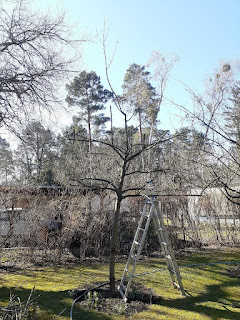A bit over 2 months ago I was asked by my Father-In-Law if I would like to prune his two apple tree's. Of course I said yes, why not? It's not like I haven't done this kind of thing before*. Given that there had been consecutive days with temperatures in the double digits (just) it was something I better get onto quickly, the new growth bud's were well on their way. In that last week or so I had noticed how many more plants were starting to put a lot of energy into their Spring 2022 campaign.
* I haven't done this specific kind of thing before
Personally I was quite chuffed, this would be a great little project to do over a day. Early on it was difficult to fill my days with meaningful things, adjusting to my temporary new life in Germany. So I chose a nice warmish day that same week. It worked out well with my son at day care and my partner busy with work, so not to notice me make a fool of myself.
 |
| BEFORE: The Red Variety |
 |
| BEFORE: Klar apfel (White Transparent) |
The trees in question are two different varieties of apple, planted around 8 years ago. One is a red, late season unknow variety for eating. The other is an early "Klar Apfel" or White Transparent, being sweet and tart, much better for cooking. These trees were around 4.5-5m tall, so I would have to enlist the help of a ladder - Acrophobia be damned!
I do like a challenge, so after dropping my son off I got straight to work. Preparing myself, I took a few deep breaths, I paced around the trees. Armed with secateurs and loppers and a healthy dose of optimism I was ready, all these years of my partner talking up my horticultural skill to her parents it was my time to shine!
But before we see how I went, lets look at the theory behind why trees need maintenance pruning to manage productivity and longevity. The type of pruning you'll need will be based on the type/species of tree (fruiting or ornamental), it's age and position (park tree or street tree). In my case a fruiting trees can gets pruned fairly regularly. This can be annually or bi-annually, depending on species - as some fruit grows on new growth, some on older. The way it is maintained aims to produce a healthy tree that produces crop year after year (once mature enough).
Trees in parks are usually selected to be robust, long lived and provide shade for park goers, hopefully for many generations to come. Species/varieties are selected that may grow taller and broader, given that they will have more space to grow compared to orchard trees or those that line our streets.
 |
| "Oh give me land, lots of land under starry skies above. Don't fence me in" |
Park trees will generally have less maintenance after establishment, where the shape of the tree will require less uniformity. During the establishment phase, trees maybe under-pruned to avoid low branches so to enable recreational opportunity and will generally have a good root protection zone created to reduce the amount of pressure and soil compaction from foot traffic.
Street trees are a little different again. They generally need to be varieties that will live better in a modified environment. They will have to live along streets that may not allow adequate space to grow or at least have opportunity to retrofit hardscapes to allow more space. They will tend to be species that have naturally narrow habits or varieties chosen for this specific form (such as fastigiate varieties).
 |
| An avenue of Plane Trees in Berlin |
Trees selected for life along our streets will need to have not only an adequate or longer establishment period (a harsher environment) but also an ongoing maintenance period of at least one more growing season (>12 months). This will ensure tree branches can be lifted to an adequate clearance, not only for pedestrians but to create a clear eye line for motorists too.
Urban forestry infrastructure has come along way from digging a tree pit that may be 1m by 30cm and a metre deep for trees. This basically meant the tree was being potted up. We now have some fairly ingenious tree "vault" systems that allow not only adequate root growth but to also house services (electricity, water etc).
These vaults aim to alleviate crowding without impeding growth. They may be expensive but when you compare it to the life long cost of maintenance and the possibility of failure it seems to be well worth the investment. The type of systems should be considered for every landscape project as it is easier (and cheaper) to have these installed at the start, again it all starts with planning.
 |
| Quercus robor Fastigiata - is an upright, columnar form variety. |
 |
| A general guide to pruning |
 |
| AFTER: The Red Apple Variety |
 |
| AFTER: The Klar apfel |
 |
| The Red Variety 12/05/2022 |
 |
| The Klar apfel 12/05/2022 |






